Main results from the publication "Participation in adult education and training in Finland. Adult Education Survey 1995"
The Adult Education Survey 1995 is the third survey of Statistics Finland on the subject of participation in adult education. It was carried out jointly by the Finnish Ministry of Education and Statistics Finland. The Finnish Ministry of Labour also participated in financing the data collection.
Persons aged 18-64 years and resident in Finland formed the population of the survey. A random systematic sample of 5 005 persons was drawn from the Central Population Register. A total of 4 107 interviews were obtained. The material was collected between September and December 1995 by personal interviews (CAPI method = Computer Assisted Personal Interviewing).
- Half of the population attended adult education in 1995
- Women more active than men
- Activity depends on initial education
- About 43 per cent of labour force in work-related adult education
- Increasing numbers of wage earners in employer-sponsored training
- Big companies most active in staff training
- Work-related training brings new job tasks
- Almost two in three interested to take part in further work-related training
- Self-improvement and professional development the primary motives for training
- Time pressure in the workplace main obstacle to participation in employer-sponsored training
- Financial restraints main obstacle to education during out-of-work time
Half of the population attended adult education in 1995
In 1995 a total of around 1.6 million people in Finland attended adult education proper, i.e. education and training specifically intended and organised for adults. This represents 48 per cent of the Finnish population aged 18-64. The median duration of education was eight days. A total of 1.8 million people or 56 per cent of the adult population studied at some educational institution or organisation over the year if also education intented primarily for young people is included. When independent studies in the form of self-learning are taken into account, the number of adult learners amounts to 2 million, which is 63 per cent of the population aged 18-64 years.
In 1995 the numbers attending adult education in Finland were at roughly the same level as five years previously. This indicates a slowdown in the steady growth that has been recorded in participation rates since 1980.
Participation in adult education and training in 1980, 1990 and 1995 (population aged 18-64)
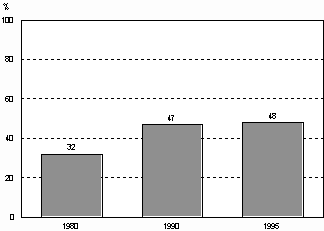
On the other hand, the numbers attending adult education in 1995 were certainly depressed by mass unemployment. Indeed for those with jobs the growth rates have been higher: in 1990 the rate of participation was 55 per cent, in 1995 60 per cent. For those outside the active labour force, the figures were 27 per cent and 33 per cent, respectively.
Women more active than men
Participation in adult education among women stood at 53 per cent compared to 43 per cent among men. The gender differences in levels of participation have remained unchanged since 1980.
Participation is highest in the age groups 30-54 years and lowest in the youngest and oldest age groups.
Participation in adult education and training by age in 1995 (population aged 18-64)
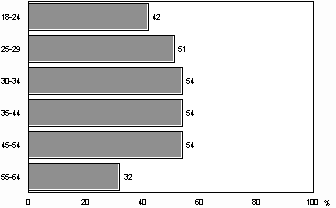
During the past fifteen years the difference between the middle-aged and the oldest age groups has narrowed down, and participation in adult education has increased rapidly in the age groups 45-54 and 55-64 years.
Activity depends on initial education
People with the highest level of initial education are the most active participants in adult education. The overall adult participation rate correlates significantly with educational attainment, and the participation rate increases with each level of education.
Participation in adult education and training by highest level of educational attainment in 1995 (population aged 18-64)
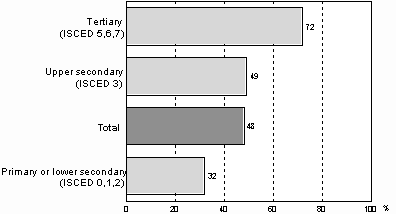
Those who have taken part in formal adult education are also more willing to study non-formally, using self-motivated learning methods.
About 43 per cent of labour force in work-related adult education
Work-related training is the most common form of adult education. In 1995 a total of around one million people in Finland took part in this type of vocational training, representing 43 per cent of the labour force. The corresponding figure in 1990 was marginally higher at 44 per cent. This trend is explained by the dramatic increase during this period in unemployment: after all the bulk of work related training is employer sponsored, which means that people who are out of work are by definition excluded.
Increasing numbers of wage earners in employer-sponsored training
In 1995 around 830 000 persons attended employer-sponsored training, representing 52 per cent of all wage earners aged 18-64. This marks an increase of about four percentage points on the figure recorded in 1990. In this comparison, however, we need to bear in mind the changes that have happened in the wage earner structure: the number of wage earners since 1990 has dropped and their level of education has risen.
Big companies most active in staff training
Large firms are more likely to provide training for their work force than small firms. Employees in firms with 500 or more employees participated in employer-sponsored training almost twice as much as those employed in companies with a staff less than 50.
Participation in employer-sponsored training by number of employees in the firm (employees aged 18-64)
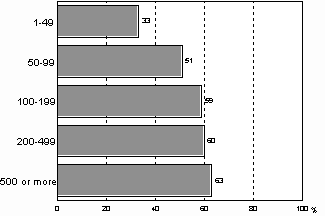
Work-related training brings new job tasks
Asked what they thought were the main effects of job-related training, the respondents referred most often to their being assigned to new job tasks at work (46 %) to promotion to more demanding job tasks (38 %) and to being able to secure their job (34 % of those who had been in training).
Effects of job- or occupation-related training (employees aged 18-64 taking part in training)
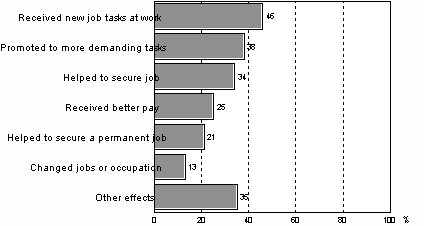
Almost two in three interested to take part in further work-related training
A large proportion, almost two thirds of the labour force was interested in participating in training within the next few years. Women showed a somewhat greater interest than men: 65 per cent of women said they would be interested in further training, the figure for men was 61 per cent. The level of interest seems to decline with age: the highest level of interest was shown in the age group 18-24 (78 %), and the lowest in the age group 55-64 (24 %).
Self-improvement and professional development the primary motives for training
The major motives for participation in training are self-improvement and the need to develop or upgrade one's professional skills and competence.
Main motives for participation in education and training (labour force aged 18-64)
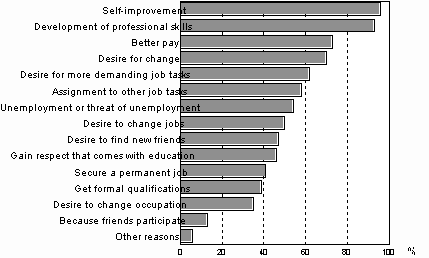
Time pressure in the workplace main obstacle to participation in employer-sponsored training
Time pressure in the workplace was the main factor that prevented or at least made it difficult for people to take part in employer-sponsored training: 59 per cent of the respondents said they were unable to participate in training because of time pressure. The next most important reasons for non-participation were that the employer does not organise training, the lack of suitable training and difficulties in being admitted to interesting training courses.
Obstacles to participation in employer-sponsored training (employees aged 18-64)
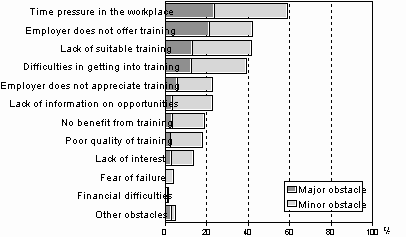
Financial restraints main obstacle to education during out-of-work time
Financial constraints, location of educational facilities and transportation problems and fatigue were mentioned most often as the main factors that prevented people from taking part in voluntary education that they paid for themselves.
Obstacles to participation in adult education and training during out-of-work time and at own expense (population aged 18-64, excluding students and conscripts)
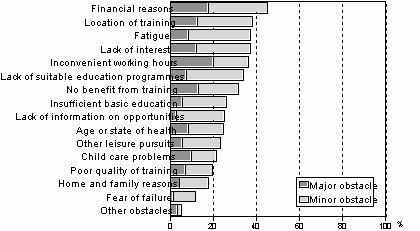
Last updated 2.11.2009
Official Statistics of Finland (OSF):
Participation in adult education [e-publication].
ISSN=2489-6926. 1995,
Main results from the publication "Participation in adult education and training in Finland. Adult Education Survey 1995"
. Helsinki: Statistics Finland [referred: 18.4.2024].
Access method: http://www.stat.fi/til/aku/1995/aku_1995_2004-05-31_kat_001_en.html

